qBitTensor - Unlocking Quantum Computing on Bittensor
Marking a major step forward in combining quantum computing with decentralized artificial intelligence (DeAI), qBitTensor Labs has announced the first subnet on the Bittensor network integrating quantum technology called "Quantum".
INSIGHTS
7/19/20256 min read
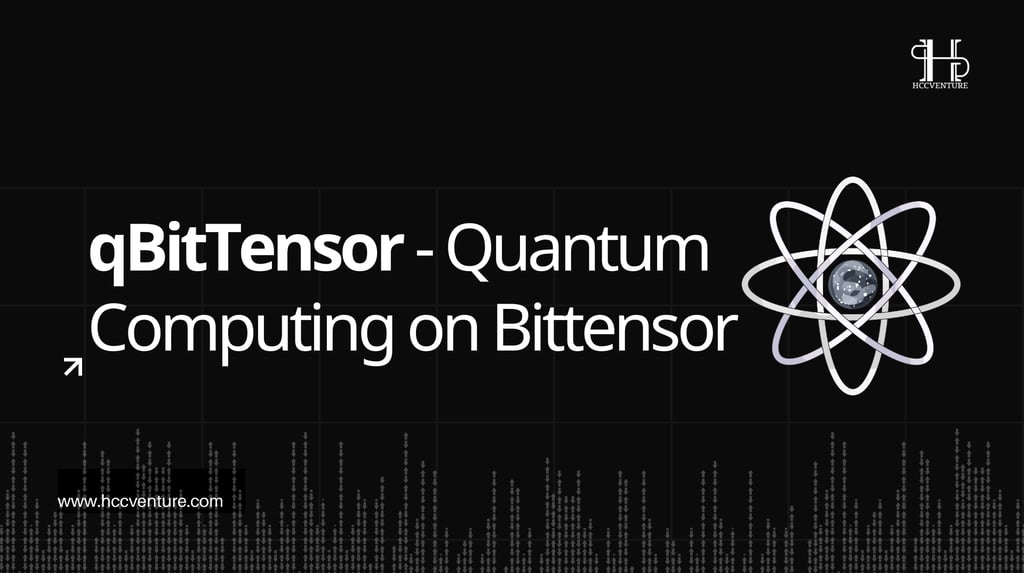

Bittensor Quantum Subnet Overview
Bittensor Quantum Subnet (qBitTensor) is a decentralized infrastructure layer dedicated to quantum computing at the core level, built on the Bittensor network architecture. This subnet not only increases the capacity of the mainnet, but also lays the foundation for collaboration between two growing fields: quantum computing and blockchain.
Machine learning, cryptography, physics simulation, and non-linear optimization can all be directly impacted by the qBitTensor Quantum Subnet, a strategic step forward to accelerate the transformation of quantum computing from a purely theoretical field to a platform.
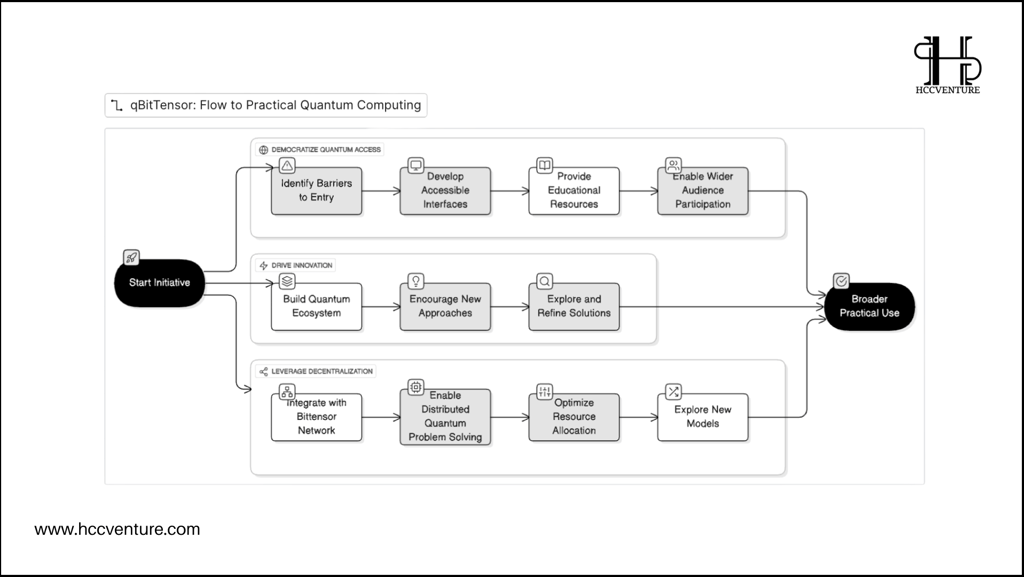

The core goals of qBitTensor
(1) Democratizing quantum access makes quantum computing easier for more people.
By creating a protocol, qBitTensor breaks this structure and allows everyone from independent researchers to startups to participate in the quantum ecosystem. Bittensor's integration of consensus and reward mechanisms provides a fair and transparent incentive for the contribution of quantum knowledge, models, and computing resources.
(2) Support innovation and optimization in quantum problem solving.
QBitTensor creates an open network environment where simulation methods, quantum algorithms, or hybrid (quantum-classical) strategies can be tested, benchmarked, and evolved through decentralized competition. When tokenomics are used to value and reward efficient computational contributions, it fosters an ecosystem of continuous innovation.
(3) Solving large quantum problems using distributed network architecture
System-level coordination is essential for quantum computing. Bittensor's decentralized neural network architecture allows qBitTensor to deploy quantum meta-learning models, Distributed Quantum Networks, or leverage idle resources from classical nodes to support pre- and post-optimization processes.
Where quantum algorithms, models, and resources are encoded into digital assets and can be coordinated and traded intelligently through the blockchain's incentive mechanism, qBitTensor intends to become a "quantum knowledge hub". This not only promotes quantum research but also opens up opportunities for the development of new decentralized applications called Q-dApps.
Peaked Circuits - Core Technology and Platform
A type of quantum circuit specifically designed to exploit the unique properties of quantum computing in a decentralized network is the main focus of the Quantum Subnet. A Peaked Circuit is a quantum circuit designed to produce a probability “peak” in the results of measurements. When executed correctly, a hidden string of bits is revealed, providing the solution to the problem.
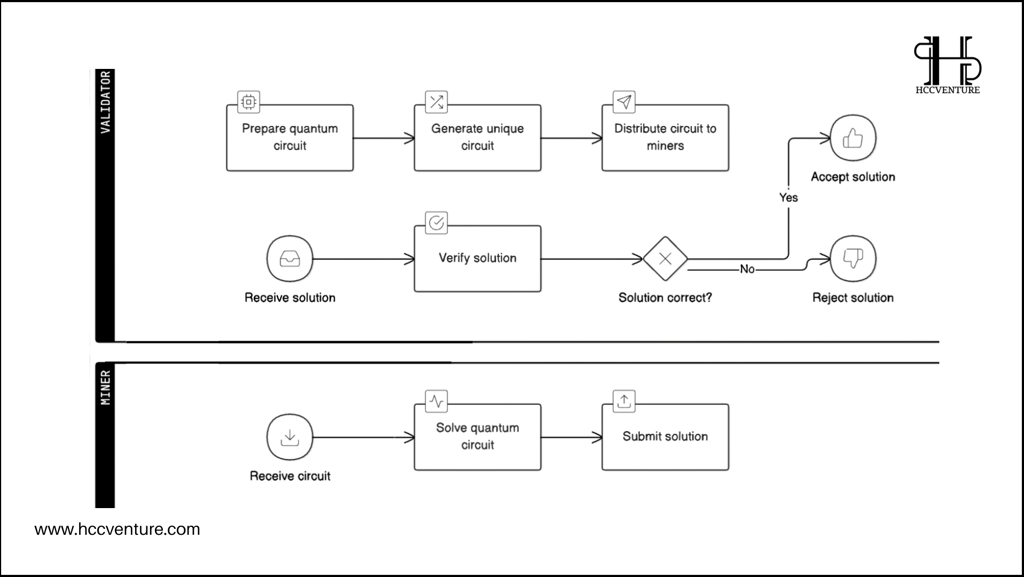

The problem in the specific quantum domain, which includes the following four basic characteristics, is solved in the first stage.
Randomizability: Validators need to be able to provide miners with a unique and unlimited source of quantum ether.
Verifiability: The goal at this stage is to implement the quantum circuit correctly rather than proving the implementation. Our problems are designed to provide true or false answers.
Scalability, also known as extensibility: it creates quantum circuits that miners can reliably solve while still being scalable.
Inaccessibility: Peaked Circuits have no "shortcuts" to solving with conventional computers; they can only be solved with quantum computing.
Peaked Circuits also supports a decentralized marketplace where miners compete to provide the best quantum solutions. SN63's scoring system is based on a time-weighted average (mean weighted average), which favors miners who can run larger and faster circuits to increase efficiency.
Integration into Bittensor
In order for miners to process, validators must create a number of quantum circuits. They will generate “unique circuits” for each miner, provide them as QASM files, and store them locally in the bit string.
Miners were pioneers in computational limits in the early stages of the project; they used QASM files and found solutions using quantum frameworks.
Remaining challenges
Quantum Processing Units (QPUs)
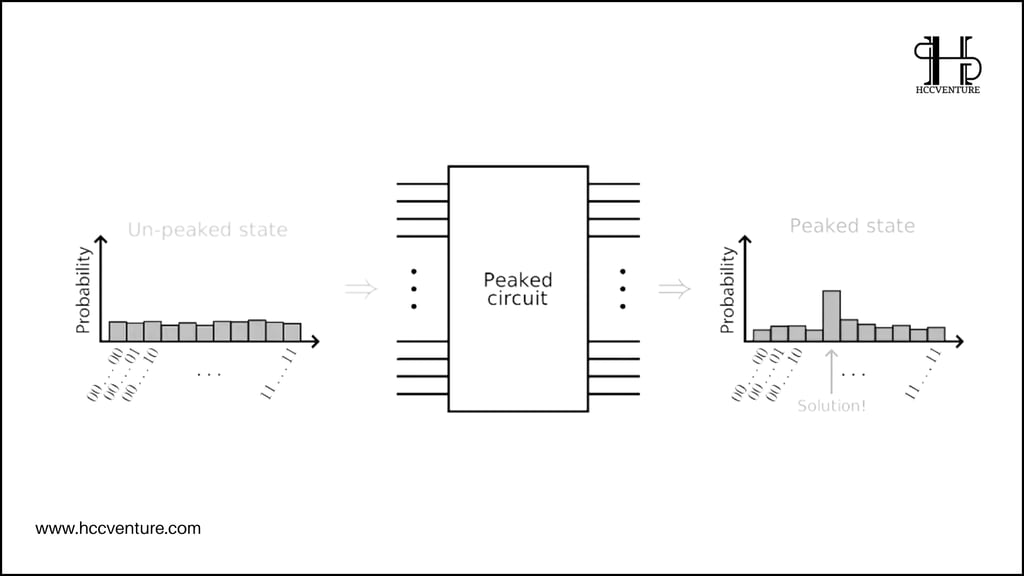

Although real quantum hardware has advanced a bit, it still has some limitations that prevent it from being widely used.
Currently, errors in the quantum state of QPUs are easy to arise and will propagate during the computation. In addition, hardware and environmental impacts continuously affect quantum operations, making it more difficult to maintain stable calculations. Accessing and performing calculations on QPUs is too expensive, and many developers cannot afford to pay enough to meet these costs. Demand often far exceeds supply, causing high-end quantum hardware to be delayed.
In a simulation of a 12-qubit, 140-depth Peaked Circuits run on an IBM Eagle QPU quantum processor, the circuit was compiled into hardware-compatible gates and run 4,096 times. Readout errors were reduced using the Mthree calibration , performed over 8,192 trials on the same 12 qubits. The circuit was generated and optimized to achieve a peak probability of 0.346575. The resulting top five states are as follows:
12 qubit quantum circuit
111011001100: 295 times (7.20%) - Target
111011001101: 19 times (0.46%)
111011000011: 19 times (0.46%)
111111001100: 19 times (0.46%)
111001111111: 18 times (0.44%)
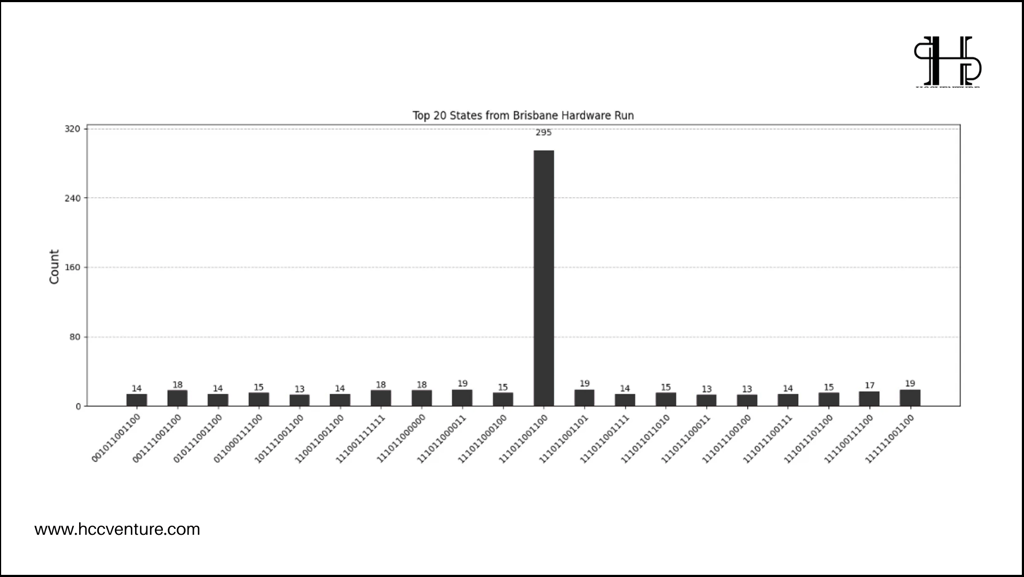

Although the experiment found peak states when running on real hardware, long queue times and high error rates make practical applications with Bittensor difficult.
Specifically, readout errors and noise reduced the probability of hitting the target from 34.6% in simulation to just 7.2% when running on the device. This error increased as larger circuits were implemented, as a 12-qubit circuit was still very small compared to the actual size of the subnet that would be used. Additionally, coherence time placed a limit on how deep the peaked circuit could be before decoherence, and budget constraints made it unfeasible to continue running.
Quantum simulation
Although simulators are easier, they have complex requirements:
Fully state-vector simulations—also known as fully vector simulations—quickly become computationally infeasible. Going beyond 50–60 qubits requires a lot of memory and processing power. Many simulators have low fidelity because they must use approximations or specialized algorithms to handle larger circuits.
Depending on the underlying algorithmic approach, the simulator can handle circuits that require significantly more qubits. Each approach has its own speed, memory footprint, and scope of application.
Strategic vision
The goal of qBitTensor's development roadmap is to create a decentralized quantum computing platform that is scalable, impactful, and efficient in the real world. The project not only implements quantum principles but also creates highly applicable technological solutions.
Expanding the types of verifiable quantum circuits is one of the first strategic steps. As qBitTensor uses Peaked Circuits, a type of quantum circuit that optimizes verification on a distributed network, it will be able to deploy more complex quantum circuits. This will help the network handle more tasks.
qBitTensor will then focus on solving real-world problems using quantum circuits. The project will gradually move toward implementing a comprehensive quantum technology stack—a set of integrated software and technologies that enable real-world problems in many important domains—rather than focusing solely on implementing abstract, experimental circuits. Specifically:
Quantum Cryptography: qBitTensor will be the platform for deploying and testing next-generation cryptographic algorithms to ensure security in a post-quantum environment.
Quantum Finance: Quantum algorithms will be used to solve problems related to derivative pricing, market behavior simulation, and portfolio optimization to increase efficiency and accuracy.
Quantum Chemistry: A platform capable of supporting molecular and electronic structure simulations at the quantum level, enabling faster research into new drugs and materials.
Conclude
qBitTensor's long-term goal is to become a fully decentralized quantum infrastructure that allows users to submit their own quantum circuits to the network. For execution and verification, these circuits will be distributed to nodes in the network, who act as "quantum miners". A community-based quantum computing model that combines the distributed architecture of blockchains with the superior potential of efficient quantum computers.
Disclaimer: The information presented in this article is the author's personal opinion on the cryptocurrency field. It is not intended to be financial or investment advice. Any investment decision should be based on careful consideration of your personal portfolio and risk tolerance. The views expressed in the article do not represent the official position of the platform. We recommend that readers conduct their own research and consult with a professional before making any investment decisions.
Compiled and analyzed by HCCVenture
Join HCCVenture here: https://linktr.ee/holdcoincventure
See more researches :
Explore HCCVenture group
HCCVenture © 2023. All rights reserved.


Connect with us
Popular content
Contact to us
E-mail : holdcoincventure_contact@hccventure.com
Register : https://linktr.ee/holdcoincventure
Disclaimer: The information on this website is for informational purposes only and should not be considered investment advice. We are not responsible for any risks or losses arising from investment decisions based on the content here.


TERMS AND CONDITIONS • CUSTOMER PROTECTION POLICY
ANALYTICAL AND NEWS CONTENT IS COMPILED AND PROVIDED BY EXPERTS IN THE FIELD OF DIGITAL FINANCE AND BLOCKCHAIN BELONGING TO HCCVENTURE ORGANIZATION, INCLUDING OWNERSHIP OF THE CONTENT.
RESPONSIBLE FOR MANAGING ALL CONTENT AND ANALYSIS: HCCVENTURE FOUNDER - TRUONG MINH HUY
Read warnings about scams and phishing emails — REPORT A PROBLEM WITH OUR SITE.
